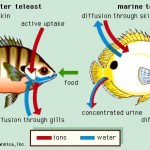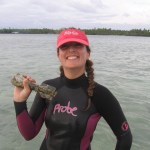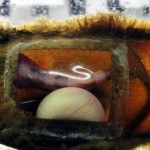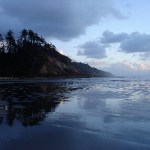marine
Today was a great day for trainees in comparative physiology! Here are some of the highlights from their sessions:
Poster presentations:
Alexis MacDonald et al., (Union College - Mentor Dr. Scott Kirkton) presented research showing that grasshopper skeletal muscles may use lactate for energy!
Similarly, Dongying Wang et al., (Saint Louis University - Mentor Dr. Daniel Warren) also showed that skeletal muscle from painted turtles may use lactate.
I guess it is not just a waste product of exercise after all...
Oral Presentations:
Image of pupfish by Nevada Fish &…
Freshwater fish are in a constant battle with their environment when it comes to maintaining their electrolyte balance as they are continuously losing ions to the surrounding water. Therefore, they have to actively absorb ions such as sodium, calcium and chloride from the water (see figure below). Prior research has shown that acidic environments cause adult and larva zebrafish to increase sodium uptake from their environment.
Depiction of water and salt homeostasis in freshwater and marine fish.
Researchers Kumai et al (University of Ottowa, Ontario, Canada) have provided evidence to…
The 2012 Festival will be here in April and we thought it would be special to honor some of the people that make the Festival happen: our fans. The Festival would not be possible without the help of our partners, sponsors and exhibitors; however our fans play a huge impact in the success of the Festival.
Leading up to the Festival, we have decided to implement a "Featured Fan" segment. Our first Featured Fan is Dr. Jessica Carilli. Jessica shares her insight into her passion: science and her excitement for the Festival below. Enjoy!
Dr. Jessica Carilli happy at work
I'm a big fan of…
Treehugger reports on the work of marine scientists at Brazil's Guaruja Aquarium, who have added a plastic window onto a shark egg so they can watch the fish develop.
In the photo above you can see the fetal bamboo shark attached to a large yolk sac. The video below gives a better view.
After noting that the unborn shark was unaffected by the window on its neonatal world, researchers removed the entire animal from its purse and allowed it to grow inside a perspex container. The work will help shed more light on how young sharks develop, an understanding of which is crucial to the…
During chase scenes, movie protagonists often make their getaway by releasing some sort of decoy to cover their escape or distract their pursuer. But this tactic isn't reserved for action heroes - some deep-sea animals also evade their predators by releasing decoys - glowing ones.
Karen Osborn from the Scripps Institute of Oceanography has discovered seven new species of closely related marine worms (annelids) that use this trick. Each species pack up to four pairs of "bombs" near their heads - simple, fluid-filled globes that the worms can detach at will. When released, the "bombs" give…
"Digital biology," as I use the phrase, refers to the idea of using digital information for doing biology. This digital information comes from multiple sources such as DNA sequences, protein sequences, DNA hybridization, molecular structures, analytical chemistry, biomarkers, images, GIS, and more. We obtain this information either from experiments or from a wide variety of databases and we work with this information using several kinds of bioinformatics tools.
The reason I'm calling this field "digital biology" and not "bioinformatics" (even though I typically use the terms as…
On Tuesday, President Bush garnered favor with marine conservationists in a last-minute move to protect over 195,000 square miles of the Pacific Ocean—more than any president in history. The new marine reserve, which includes parts of the Mariana Trench in addition to several coral reefs and atolls, will be protected from mining, fishing, oil exploration and other destructive activities. ScienceBlogger James Hrynyshyn celebrated Bush's decision, but reminded, "By failing to accept the reality of climate change...he will more likely be remembered as the president who missed the boat."
Back in March of 2007, we brought you the story of an enormous (colossal really) squid, captured by New Zealandish fishermen and brought back for examination at the University of New Zealand. The frozen squid posed challenges for the researchers who realized that it would take so long to thaw that the outer parts would be rotting before the core had even melted (also an appropriate description of my brother Benny's heart).
Well the marine biologists made their move today, thawing out the colossal squid in a bath of cool water. Had the water been too hot, they were worried it might crack the…
Dentistry under the sea looks a lot less painful but potentially much more dangerous for the hygienist.
Moray and cleaner shrimp. Photo credit to Erwin Kodiat
Sand Diver and Pedersen's cleaner shrimp. Photo credit to Reef Reflections
Fun fact: adorable cleaner shrimp are notable for crawling down people's throats and laying eggs in their chest! Photo credit to Michael Haas.



